Fracture and Structural Integrity: The Podcast
Stay at the cutting edge of fracture mechanics and structural integrity research with the official podcast of the Fracture and Structural Integrity journal. Join us for insightful interviews with top researchers, in-depth discussions of groundbreaking papers, and explorations of emerging trends in the field.
RSS Spotify YouTube Amazon Music
Damage of additively manufactured polymer materials: experimental and probabilistic analysis
2025-06-11
https://www.fracturae.com/index.php/fis/article/view/5465
This paper presents a study on the tensile, fracture, damage, and reliability properties of 3D printed polylactic acid (PLA), based on a series of experiments. The study focuses on polylactic acid (PLA) samples produced using fused filament manufacturing (FFF) technology, specifically examining unidirectional print orientations of 0°, 45°, and 90°. Tensile testing demonstrated significant anisotropy in mechanical behavior, The specimens oriented at 0° exhibited the highest tensile strength, while those at 90° showed the lowest. An increase in artificial crack length (a) resulted in a progressive decrease in the mechanical properties. Weibull analysis confirmed the presence of significant anisotropic behavior in 3D-printed PLA specimens, with ultimate stress (σu0) values ranging from 39.82 MPa for the 90° orientation to 44.69 MPa for the 0° orientation, and elastic stress (σe0) values from 35.49 MPa (90°) to 39.11 MPa (0°), indicating greater strength for the 0° oriented specimens. Damage evolution analysis showed accelerated damage, with the 90° orientation demonstrating the fastest rate of damage compared to the 0° and 45° orientations. This indicates that the 90° orientation is more vulnerable to crack propagation and has diminished structural integrity under stress.
DownloadFiletype: MP3 - Size: 24 MB - Duration: 20:36m (160 kbps 24000 Hz)
Powered by Podcast Generator, an open source podcast publishing solution | Theme based on Bootstrap
